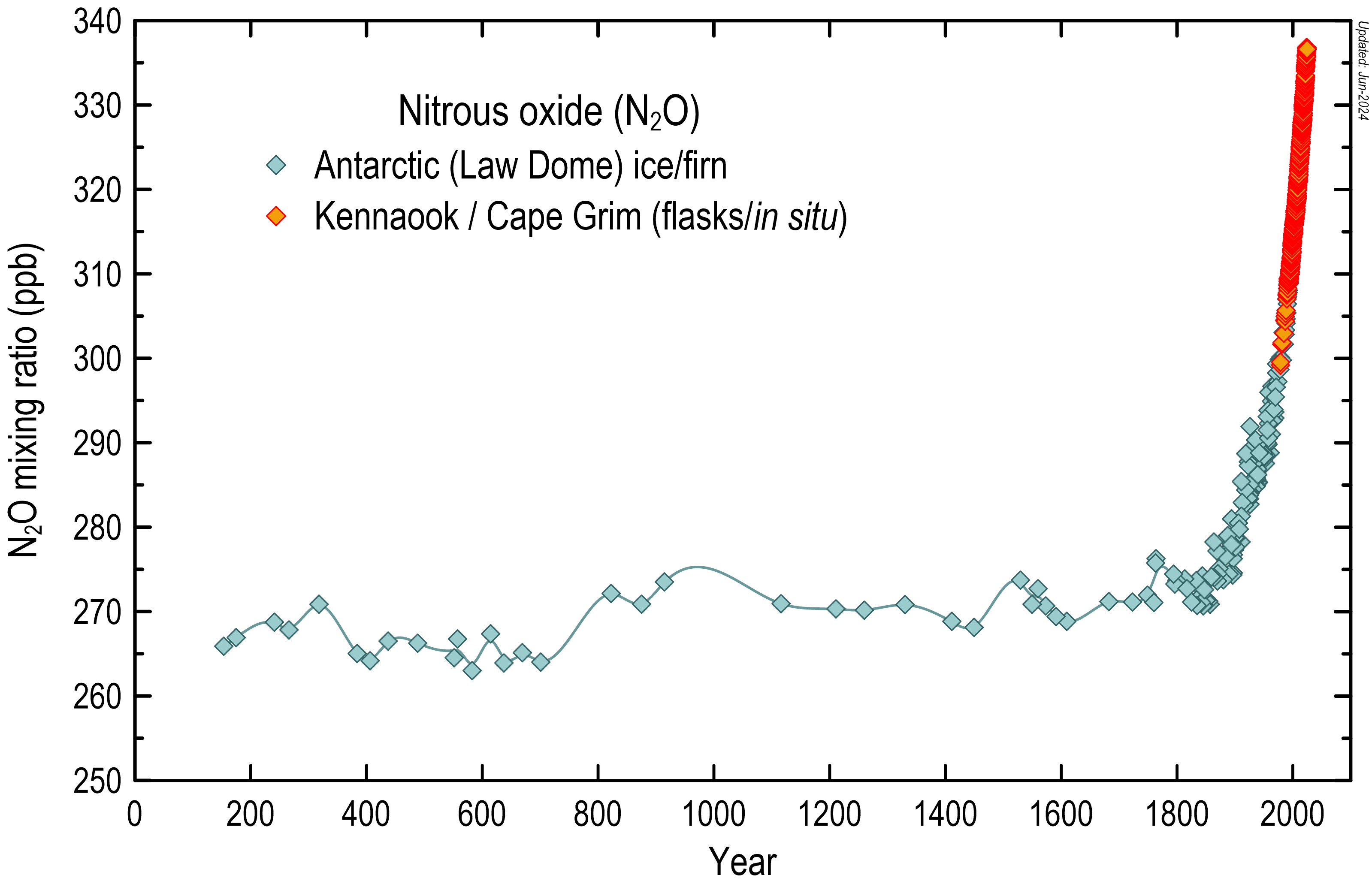Global atmospheric nitrous oxide
Nitrous oxide (N₂O) is the third most important greenhouse gas (after carbon dioxide and methane) contributing to human-driven climate change. Nitrous oxide remains in the atmosphere for over 100 years. It is also an ozone-depleting substance, meaning that it reduces the amount of ozone in the atmosphere and contributes to the annual hole in the ozone layer. As reported in the latest global nitrous oxide budget, the total annual anthropogenic N₂O emissions have increased by 40 per cent (or 1.9 million tonnes of nitrogen per year) in the past four decades (1980-2020).

These emissions have accumulated in the atmosphere at an increasing rate. The annual atmospheric N₂O growth increased from 5.2 tons per year during the 2000s to almost 7.2 million tons per year in the 2010s. The growth has further accelerated between 2020-2022, with growth rates higher than any previously observed year since 1980 (the start year of this assessment), and about 30 per cent higher than in the past decade.
Atmospheric concentrations of N₂O reached 336 parts per billion in 2022. The atmospheric increase is smaller than the emissions increase because chemical sinks remove N₂O from the atmosphere.
The rate at which nitrous oxide is accumulating in the atmosphere is faster than any of the illustrative emission scenarios used by the Intergovernmental Panel on Climate Change.
This N₂O contribution is consistent with scenarios that puts Earth on track for an increase in average global temperatures of well above three degrees Celsius by 2100 compared with pre-industrial temperatures. To keep global warming to the Paris Agreement target of below two degrees Celsius we need to reduce anthropogenic nitrous oxide emissions on average by at least 20 per cent by 2050 from 2019 levels.
Main sources and sinks of nitrous oxide
Nitrous oxide is emitted from both human-derived and natural sources. Emissions from natural sources (such as soils and oceans) have not changed much in recent decades. Whereas emissions resulting from human activities have grown by 40 per cent over the past four decades.
The main source of human-derived emissions is agriculture. Agricultural production (due to the use of nitrogen fertilisers and animal manure) contributed 72 per cent of the total anthropogenic N₂O emissions in the last decade. Other human-derived sources of nitrous oxide include fossil fuels, waste and wastewater, and biomass burning.
The top five country emitters by volume of anthropogenic N₂Oemissions in 2020 were China (16.7 per cent), India (10.9 per cent), USA (5.7 per cent), Brazil (5.3 per cent), and Russia (4.6 per cent).
Anthropogenic N₂O emissions in Australia have been stable over the past two decades.
The Global Nitrous Oxide Budget 2024 is the second budget of its kind. This project is supported with funding from the Australian Government under the National Environmental Science Program's Climate Systems Hub, and uses data from the CSIRO atmospheric network of air measurements.
Global atmospheric nitrous oxide
Nitrous oxide (N₂O) is the third most important greenhouse gas (after carbon dioxide and methane) contributing to human-driven climate change. Nitrous oxide remains in the atmosphere for over 100 years. It is also an ozone-depleting substance, meaning that it reduces the amount of ozone in the atmosphere and contributes to the annual hole in the ozone layer. As reported in the latest global nitrous oxide budget, the total annual anthropogenic N₂O emissions have increased by 40 per cent (or 1.9 million tonnes of nitrogen per year) in the past four decades (1980-2020).
These emissions have accumulated in the atmosphere at an increasing rate. The annual atmospheric N₂O growth increased from 5.2 tons per year during the 2000s to almost 7.2 million tons per year in the 2010s. The growth has further accelerated between 2020-2022, with growth rates higher than any previously observed year since 1980 (the start year of this assessment), and about 30 per cent higher than in the past decade.
Atmospheric concentrations of N₂O reached 336 parts per billion in 2022. The atmospheric increase is smaller than the emissions increase because chemical sinks remove N₂O from the atmosphere.
The rate at which nitrous oxide is accumulating in the atmosphere is faster than any of the illustrative emission scenarios used by the Intergovernmental Panel on Climate Change.
This N₂O contribution is consistent with scenarios that puts Earth on track for an increase in average global temperatures of well above three degrees Celsius by 2100 compared with pre-industrial temperatures. To keep global warming to the Paris Agreement target of below two degrees Celsius we need to reduce anthropogenic nitrous oxide emissions on average by at least 20 per cent by 2050 from 2019 levels.
Main sources and sinks of nitrous oxide
Nitrous oxide is emitted from both human-derived and natural sources. Emissions from natural sources (such as soils and oceans) have not changed much in recent decades. Whereas emissions resulting from human activities have grown by 40 per cent over the past four decades.
The main source of human-derived emissions is agriculture. Agricultural production (due to the use of nitrogen fertilisers and animal manure) contributed 72 per cent of the total anthropogenic N₂O emissions in the last decade. Other human-derived sources of nitrous oxide include fossil fuels, waste and wastewater, and biomass burning.
The top five country emitters by volume of anthropogenic N₂Oemissions in 2020 were China (16.7 per cent), India (10.9 per cent), USA (5.7 per cent), Brazil (5.3 per cent), and Russia (4.6 per cent).
Anthropogenic N₂O emissions in Australia have been stable over the past two decades.
The Global Nitrous Oxide Budget 2024 is the second budget of its kind. This project is supported with funding from the Australian Government under the National Environmental Science Program's Climate Systems Hub, and uses data from the CSIRO atmospheric network of air measurements.
Related research
Read more about our research to monitor, understand and ultimately reduce nitrous oxide emissions.
